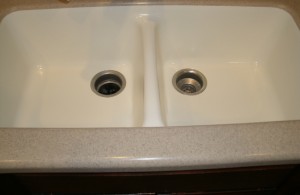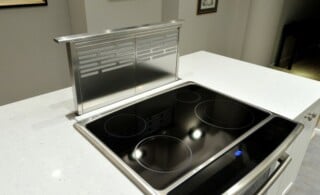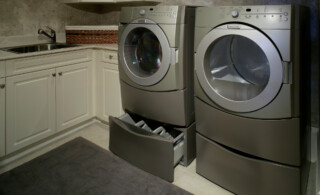 Garbage disposals are one of the handiest appliance investments in the home. Interestingly, they are almost exclusively an American item. Since the original InSinkErator was invented in 1927, adoption has grown to the point where almost half the households in the United States have a disposal unit. Those traveling to the United Kingdom and Canada will be hard pressed to find this useful device.
Garbage disposals are one of the handiest appliance investments in the home. Interestingly, they are almost exclusively an American item. Since the original InSinkErator was invented in 1927, adoption has grown to the point where almost half the households in the United States have a disposal unit. Those traveling to the United Kingdom and Canada will be hard pressed to find this useful device.
Waste Disposal Basics
Waste disposal is always one of the biggest challenges in any country. Americans traveling abroad are often amazed to find how inefficient many foreign disposal systems are, and how much that affects the quality of life. Many are grateful to return home, knowing how well U.S. disposal systems quickly separate citizens from their trash.
The Disposal or the Trash Bin?
When you are cleaning up after a meal, you have two effective ways to get rid of the excess food: wash it down the sink or toss it in the trash can. Which is better? Many would say to use the sink. You are right there already, washing the dirty dishes. As long as you are not trying to get rid of chicken bones or something similar, you can just wash excess right down the sink and get rid of it right away. It will not sit in the trash can, potentially smelling up the kitchen, and it is one less thing to haul out to the garbage bin later.
However, it is important to understand that the food waste that goes into the trash bin will eventually end up in a land-fill while the excess food that goes into the sink ends up in the sewer system. Although it does not bear close scrutiny, the sewer system is part of the water supply system. It does not help anyone if homeowners challenge the city’s ability to clean up the waste they put down the sink.
Why is this information important? Because this information helps users decide whether they should use their garbage disposal instead of the trash for a particular type of food, in order to protect their water supply. It also helps keep the disposal unit clean and working properly.
Ready to start your garbage disposal?
Find ProsSigns the Disposal May Need Attention
Many homeowners go their whole lives without dealing with a dirty disposal unit. However, it is always a good idea for people to keep the warning signs in mind:
- Odor – when your sink begins to smell like your trash can, you know the disposal unit is not working properly.
- Noise – anyone who has dropped a spoon or other metal utensil knows the racket a disposal makes when the blades meet an immovable object. Similarly, food clogs cause the disposal to make a straining sound, not unlike a car engine struggling to start on a cold day.
- Visible waste – a mess will show at the mouth of the sink when the disposal is malfunctioning.
The Bad Boys of Disposal
As tempting as they may be, there are certain foods that are anathema to in-sink disposal units. Just say no to:
- Egg Shells – although an urban legend says that egg shells sharpen disposal blades and scour the walls of the unit, many find that ground shells actually form a clogging paste when too many are added at a time.
- Banana peels – the peels are made of strands that clog disposal axles like hair does in a vacuum cleaner.
- Potato peels
- And last but not least: any food with heavy grease.
In addition, always make sure there is sufficient water flow as the disposal is running, in order to properly flush the waste.
When You Have to Clean
When an ounce of prevention fails, a pound of cure can be fairly manageable. If the disposal motor still runs and the drain is not backed up, there are several simple methods to restore clear flushing action:
- Baking Soda and Vinegar – vinegar is a mild acid while baking soda is a base. Together, they form an effective cleaning agent. Start by pouring a half cup of baking soda into the disposal unit. Then carefully pour a cup of white vinegar on top of the soda. It is a good idea to use protective eyewear for this step. While the mixture is fizzing and cleaning, boil a medium size pot of water. When it is ready, pour it steadily down the drain.
- Water and Bleach – bleach is used to make a more powerful cleansing agent. Again, don your protective eyewear and mix a gallon of water with one tablespoon of liquid chlorine bleach. Then, pour this mixture very slowly down the sink drain and let it sit. After several minutes, wash away the residue with a stream of hot water from the tap. The bleach is an excellent germ-killing agent. However, too much bleach will harden any grease buildup in your garbage disposal.
- Ice and Citrus Peels – a great maintenance procedure is to place several ice cubes into the disposal and running the unit to clean the blades. Adding citrus rinds at the same time will freshen the unit.
Dealing With Full Clogs
A full clog can be more work, but still manageable. Follow these steps:
- The first all-important step: unplug the unit. Flip the starter switch to make doubly-sure the disposal is unplugged.
- Remove everything from under the sink and put down a thick cloth to absorb any spills.
- Attack the most likely source of the clog: grease buildup. Disconnect the pipe below the unit and check for blocks.
- Read the manufacturer and model number from the unit and download the manual. Use the manual to locate the manual turning point. Use a wrench to turn the grinding axle, and see if that frees the blades.
- At this point, consider calling a plumber. If you have a homeowner’s warranty, you will likely be covered for this type of work.
Above all, during this process, make sure to keep your fingers out of the unit.
Conclusion
When you are ready, choose a week to be your household’s garbage disposal week. During this time, pay special attention to what you put into your disposal. Afterwards, good disposal maintenance habits will be a part of your routine. If the unit does clog, save yourself some money before you call the plumber and try a few of the steps listed above.
 Undercounter Refrigerators
Undercounter Refrigerators  Green Appliances
Green Appliances  Finding the Right Electric Range for Your Kitchen
Finding the Right Electric Range for Your Kitchen  Wall Ovens
Wall Ovens  The Basics of Gas Appliances
The Basics of Gas Appliances 

I hope more people read this and learn how to use the garbage disposal correctly! So many people think they can throw anything in there and don’t have to maintain it, but it’s not like that at all.
I think the biggest sign our disposal needs attention is how terrible it smells! I can’t walk by the kitchen sink without nearly gagging because it’s so awful. I tried putting a lemon down there and letting that get all ground up, and it helped for a couple of days. I will have to try the baking soda and vinegar trick today and see if that helps better than the lemon. Thanks for the great tips!
Nice post indeed. Love some of your ideas for sure . Rock salt is another debated because it is a harder item to grind to. However, rock salts edges are supposed to be good for scraping off gunk in the grinding chamber because the edges of the salt are sharp. It is as simple as putting a small amount of rock salt in the grinding chamber and turning on the water and the garbage disposal.
You will hear the rock salt bound around until it dissolves or goes down the drain.
I use the ice cube treatment along with a commercial product that sanitizes. I was shocked at the amount of food debris that bubbled up the first time. I also use baking soda/vinegar when there is an odor. Here’s another trick for disposing of meat scraps, bones, and such, especially in warm weather. Place a disposable plastic container (cut off the top of a quart milk jug, for example) in your freezer and deposit scraps in it until trash day. My mom gave me this easy solution. She lived in the southern U.S. Those of us who live in below-freezing temps for part of the year can throw scraps in the outdoor trash. It’s going to freeze anyway, right?